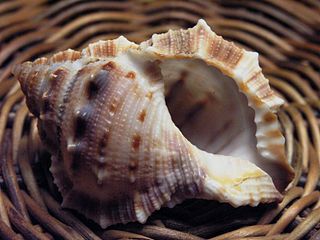
The great spider crab, Hyas araneus, is a species of crab found in northeast Atlantic waters and the North Sea, usually below the tidal zone.

Hydractinia echinata is a colonial marine hydroid which is often found growing on dead, hermit-crabbed shells of marine gastropod species. This hydroid species is also commonly known as snail fur, a name which refers to the furry appearance that the hydroids give to a shell.

Hydractinia symbiolongicarpus is one of the 30 + Hydractinia species known worldwide. This saltwater animal, from here on referred to as Hydractinia, is at the base of the Cnidaria phylum and in many ways, is similar to the freshwater Hydra. In the wild, Hydractinia feed on smaller invertebrates found in the shallow mud, however in laboratory environments they are fed brine shrimp. Hydractinia symbiolongicurpus and its sibling species, Hydractinia echinata, are the two species from the genus Hydractinia on which most work has been published.

Bufonaria is a genus of medium-large sea snails, marine gastropod molluscs in the family Bursidae, the "frog snails".

Galathea strigosa is a species of squat lobster in the family Galatheidae. It is found in the northeast Atlantic Ocean, from the Nordkapp to the Canary Islands, and in the Mediterranean Sea and Red Sea. It is edible, but not fished commercially. It is the largest squat lobster in the northeast Atlantic, reaching a length of 90 millimetres (3.5 in), or a carapace length of 53 mm (2.1 in), and is easily identified by the transverse blue stripes across the body.

Rimula is a genus of sea snails, marine gastropod mollusks in the family Fissurellidae, the keyhole limpets.
Morula echinata, common name the prickled-armed ricinula, is a species of sea snail, a marine gastropod mollusk in the family Muricidae, the murex snails or rock snails.
Pagodula echinata is a species of sea snail, a marine gastropod mollusk in the family Muricidae, the murex snails or rock snails.
Gourmya is a genus of sea snails, marine gastropod mollusks in the family Cerithiidae.
Neoiphinoe echinata is a species of small sea snail, a marine gastropod mollusk in the family Capulidae, the cap snails.
Neoiphinoe is a genus of small sea snails, marine gastropod mollusks in the family Capulidae, the cap snails.

Flustra foliacea is a species of bryozoans found in the northern Atlantic Ocean. It is a colonial animal that is frequently mistaken for a seaweed. Colonies begin as encrusting mats, and only produce loose fronds after their first year of growth. They may reach 20 cm (8 in) long, and smell like lemons. Its microscopic structure was examined by Robert Hooke and illustrated in his 1665 work Micrographia.

Minous, is a genus of marine ray-finned fishes, it is the only genus in the tribe Minoini, one of the three tribes which are classified within the subfamily Synanceiinae within the family Scorpaenidae, the scorpionfishes and their relatives. They are commonly known as stingfishes. They are found in the Indo-West Pacific.

Hydractinia altispina, or high-spined commensal hydroid, is a small colonial hydroid in the family Hydractiniidae.
Cerithiopsida is a genus of sea snails in the family Newtoniellidae.

Diplecogaster bimaculata, the two-spotted clingfish, is a species of fish in the family Gobiesocidae found in Black Sea, Mediterranean Sea and Atlantic Ocean where it is found on rocks and among seagrass or shell beds.

Mancinella echinata, common names prickly rock shell, prickly rock snail, is a species of sea snail, a marine gastropod mollusk, in the family Muricidae, the murex snails or rock snails.

Awheaturris is a genus of sea snails, marine gastropod mollusks in the family Raphitomidae.
Schuchertinia milleri, commonly known as the Miller hydractinia, hedgehog hydroid or snail fur, is a small colonial hydroid in the family Hydractiniidae, found in the eastern Pacific Ocean. It forms mat-like colonies on rocks, or sometimes on the mollusc shells occupied by hermit crabs.













